The Viper probe droid, frequently called a probot or Imperial probe droid, represented an advanced deep-space exploration and reconnaissance unit. Arakyd Industries manufactured this probe droid model, which drew inspiration from the early success of Galalloy Industries' probe droids. The probot's design was also greatly influenced by the work of Viper Sensor Intelligence Systems, a company that Arakyd acquired during the Clone Wars. Although primarily used by the military, these droids were categorized as class two exploration droids.
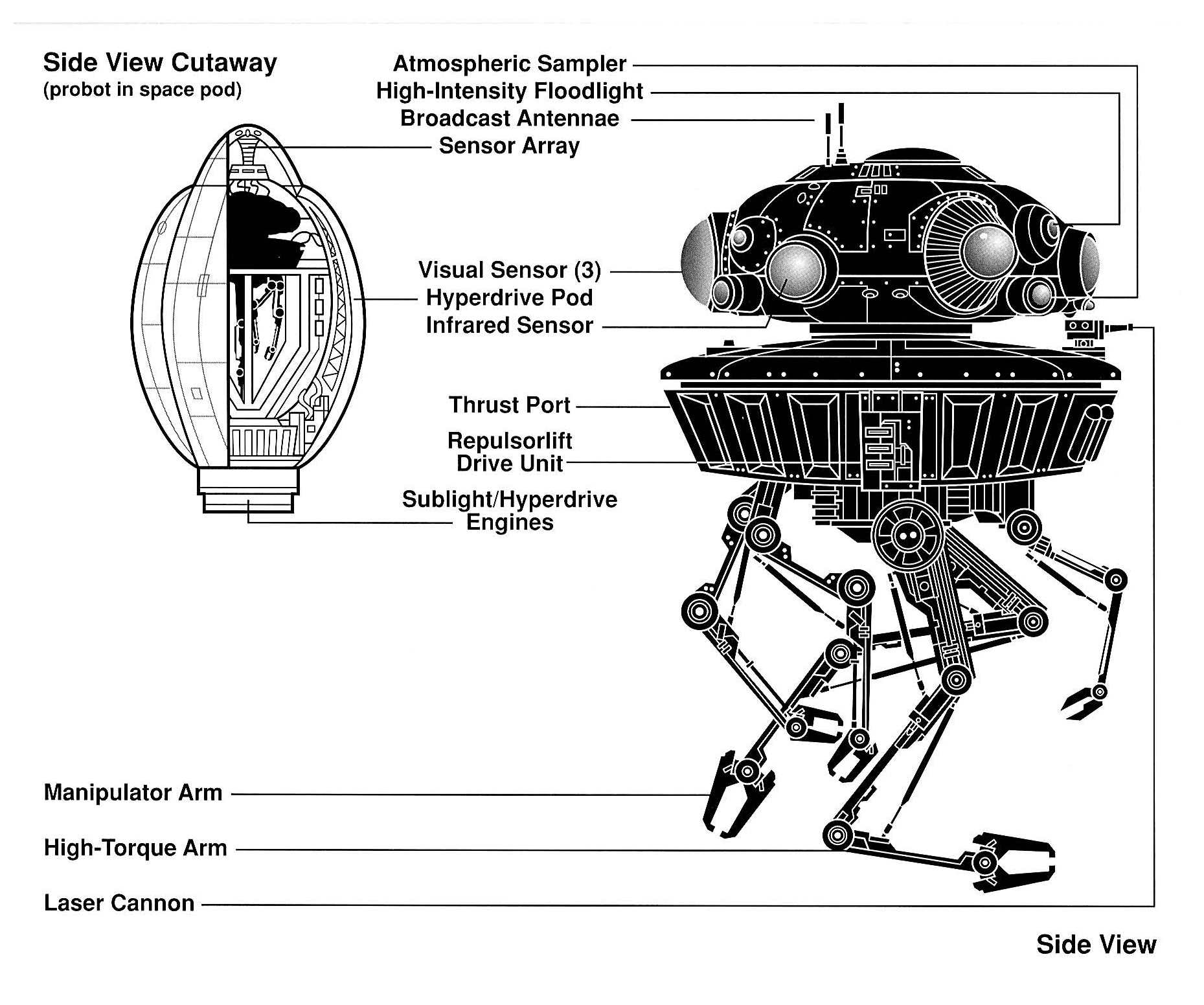
The Viper droid, equipped with light armor, stood at 1.6 meters tall. It featured five manipulator arms extending from its central pod, along with several retractable sensor arms designed for sample collection. The domed head was covered in high-resolution receivers and sensors, including motion, acoustic, sonic, and seismic sensors, as well as a radiation meter, magnetic imager, and holocamera. Its atmosphere sensor could identify a planet's atmospheric class within 30 minutes. A repulsorlift generator enabled movement across all types of terrain. One of the arms delivered high-torque, and a floodlight was mounted on the droid's head. Furthermore, the probe droid transmitted an audio encrypted imperial computer code set of an unknown serial number during communications.
A high-frequency HoloNet transceiver relayed information back to commanding officers. The repulsorlift engines allowed the droid to traverse terrain at speeds up to 40 km/h, while its arms collected samples. Vipers were deployed to their designated areas via single-use, custom-built hyperspace pods. They were often positioned along the perimeters of strategically important star systems and hyperlanes to serve as automated sentinels.
The typical cost for a Viper probe droid was 14,500 credits. They could be deployed from Galactic Empire Command centers.
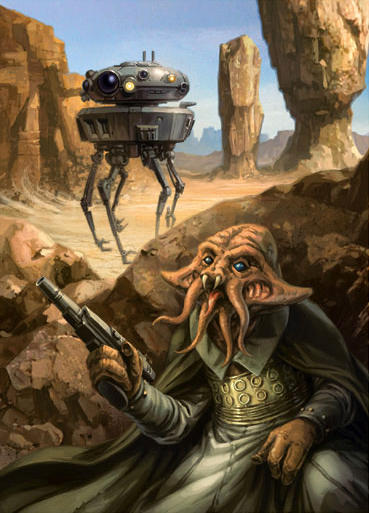
Arakyd originally engineered its probe droids for the Galactic Republic to conduct surveys and exploration. Certain droids transitioned to military applications; for instance, the Confederacy of Independent Systems utilized enhanced probots during the invasion of Kashyyyk during the Clone Wars. Following the Republic's collapse and the Galactic Empire's rise, Arakyd developed updated probot versions with advanced military-grade sensors and equipment, marketing them as Viper probe droids.
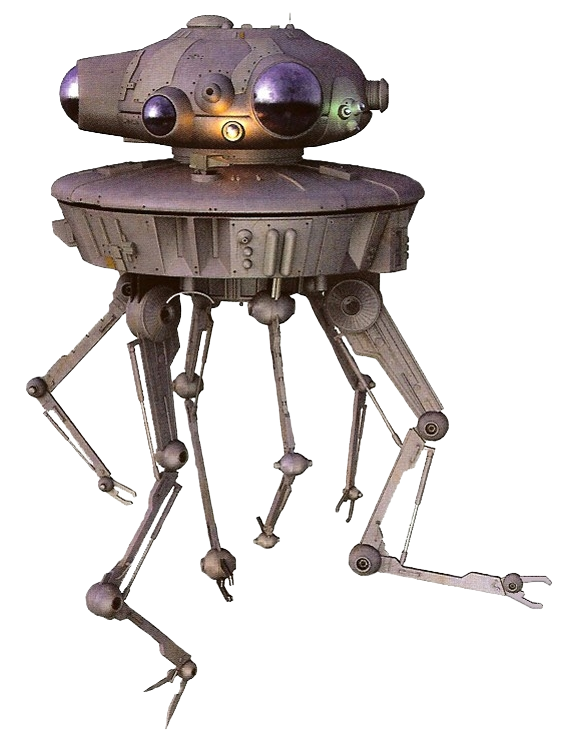
Under Darth Vader's direct supervision, Viper probots serving the Empire received upgrades, including a blaster cannon, a self-destruct mechanism, and, in some instances, deflector shields. These armed probe droids became part of the security and defense forces at various Galactic Empire installations, such as Gromas Mines, Imperial Detention Center, the area around the Imperial Security Operations building in the Imperial City, and even within the Executor. Moff Rebus used some droids to secure his hideout in Anoat City, among other locations. Rebel agent Kyle Katarn encountered and neutralized these droids while sabotaging the Dark Trooper Project.
The Imperial Intelligence's Analysis Bureau also widely deployed these droids as remote surveillance units, primarily in the Outer Rim Territories. In active war zones, probots frequently supported the Imperial Navy by monitoring traffic and providing early warnings of impending attacks.
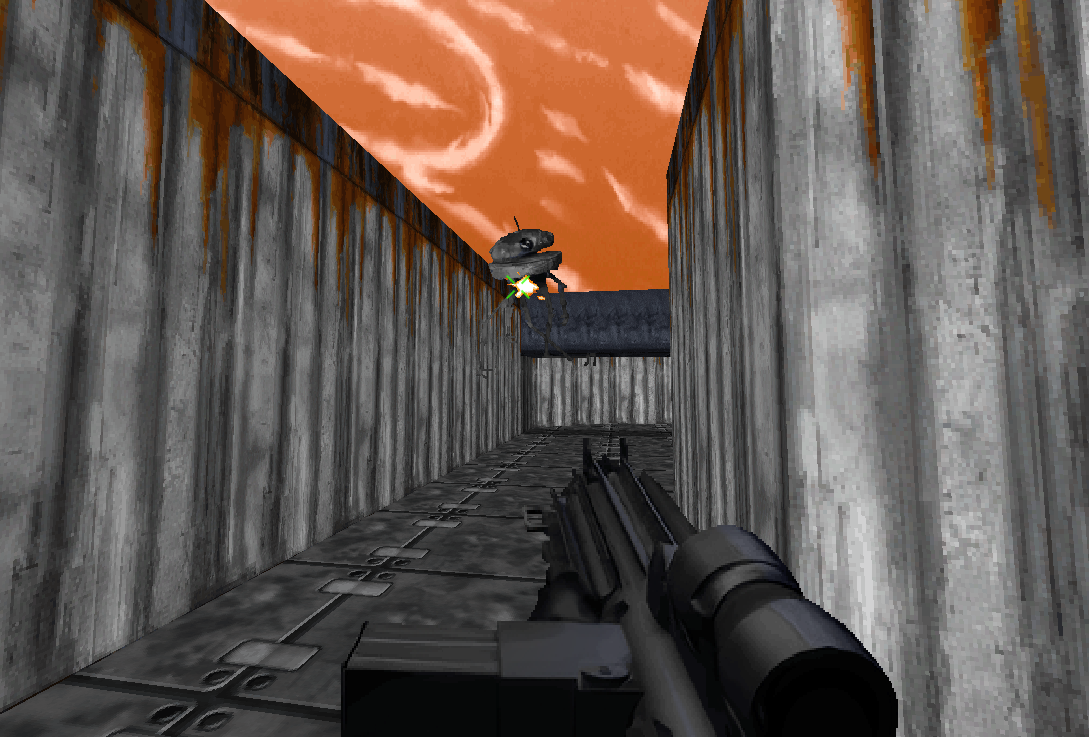
Soon after the Battle of Tatooine, the Empire dispatched probe droids to Tatooine in an attempt to retrieve the stolen Death Star plans. Six months following the Battle of Yavin, the Galactic Empire deployed a detachment of probe droids to root out Rebel Commander Luke Skywalker. Skywalker and Rogue Squadron destroyed these droids. Probe droids also scouted ahead for Imperial strike forces during operations such as the Reytha campaign and the battle at Corellia, and were sent on search missions like at Chorax. Several were also sent to Dantooine as security while the Imperials arrived on the planet to detain the defecting Imperial officer Tycho Celchu.
After the Evacuation of Yavin, the Empire commissioned thousands of probe droids to search the galaxy for concealed Rebel Alliance bases. This new large line of Viper droids was manufactured on Mechis III. Darth Vader personally oversaw the project from its inception, visiting the production facility and assigning ships from his Death Squadron to deploy the droids across the vast expanse of space. The overarching military and political objective was to locate the elusive and mobile Alliance High Command. Vader was particularly fixated on finding Luke Skywalker. He issued specific instructions to program the probes to prioritize both Skywalker and the Millennium Falcon, Han Solo's celebrated starship.
The Empire's success with Arakyd's military Viper model led to the development of the C-Viper probe droid, a more streamlined version intended for planetary law enforcement agencies.
When Darth Vader ordered the construction of thousands of Viper probe droids on Mechis III, he was unaware that the rogue assassin droid IG-88 had taken control of the planet's automated factories. IG-88 was secretly planning a Droid Revolution where droids across the galaxy would unite and overthrow organic life. Vader's visit to Mechis represented the closest the conspiracy came to discovery; however, the IG droids successfully concealed their true purpose, and Vader only perceived a minor disturbance that he could not pinpoint.
Vader impressed IG-88 with his raw power and blending of organic and mechanical traits. IG-88 decided to incorporate Vader and his commissioned probe droids into his grand plan. He provided them with a secondary set of instructions. They received the same sentience programming as the IG-88 droids, transforming them into clandestine soldiers in his Droid Army. While carrying out their Imperial missions, they were to secretly transmit their intelligence back to Mechis III. Thus, they acted as the eyes and ears of the revolution. Through them, IG-88 would gather insights into the Empire's plans, actions, and vulnerabilities. The droids ultimately planned to seize the Empire's power for themselves.
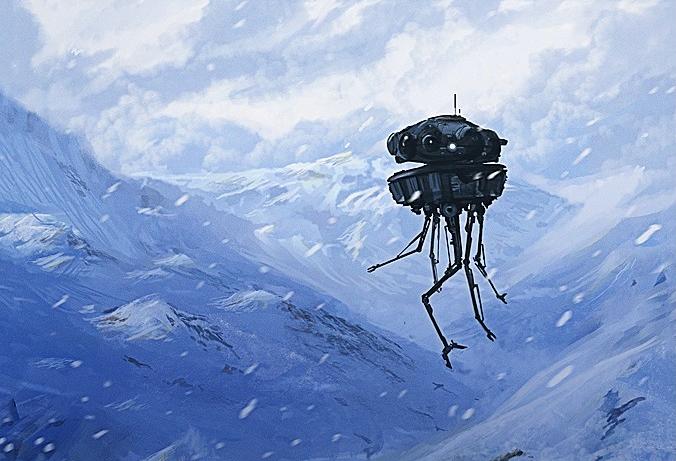
One Arakyd Viper, deployed from an Imperial II-class Star Destroyer belonging to Death Squadron, landed on the ice planet Hoth as part of Vader's extensive search for the hidden Rebel base. After exiting its hyperspace pod, the probe droid detected a weak comm signal and began moving toward its likely source. It encountered a wampa ice creature, initially probing it with its laser before vaporizing it when the creature posed a threat. During a severe snowstorm that night, the probe droid shut down most of its systems, activating its particle shield to protect itself from the heavy snowfall.
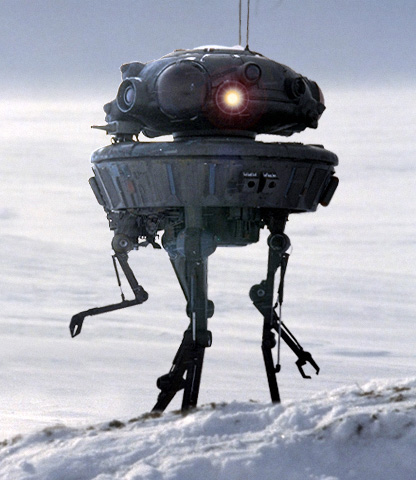
The following morning, the droid entered Zone 12 outside the Rebels' Echo Base. It detected the base's large deflector shield generator and began recording it, transmitting the data to Darth Vader's flagship, the Executor. It continued to map other aspects of Echo Base and its defenses, providing critical information for the Empire's upcoming attack. IG-88, back on Mechis III, also received this information. IG-88B traveled to Hoth to observe and learn from Vader's subsequent actions.
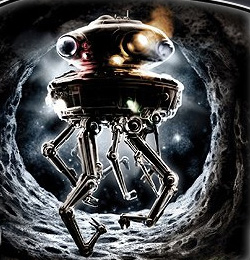
Warning sensors placed by Han Solo had already detected traces of the probe, alerting the Rebels to an unidentified object. A lone trooper at Station 3-8 then detected the droid, but the probe droid destroyed the station with its blaster before the trooper could visually confirm its identity. Solo and Chewbacca were dispatched to the nearby Ceyan Range. The probe detected their approach but was outmatched. While Chewbacca created a diversion, Solo ambushed the droid from another direction. Realizing it was trapped, the droid activated its self-destruct mechanism to prevent capture.
The Rebels understood they had been discovered and prepared to evacuate. On the Executor, Admiral Kendal Ozzel downplayed the probe's incomplete data, but Vader was certain that the probe droid had located the hidden Rebel base. Death Squadron proceeded to Hoth and launched a full-scale ground assault, occupying the base and scattering the Rebels.
Following the Battle of Hoth, Arakyd and the Empire collaborated to produce the Infiltrator probe droid, a new version of the Viper designed to sabotage and take control of starships.
The would-be droid revolution, involving numerous Viper probes as co-conspirators, was extinguished in 4 ABY. IG-88A uploaded his droid consciousness into the computer core of the second Death Star as a final preparatory step. IG-88 intended to send a signal to droids everywhere, including the Viper probe droids, to revolt against their masters. However, the Battle of Endor resulted in the Death Star's destruction, ending the planned revolution.
As the Empire's power waned against the New Republic, it continued to utilize Viper probe droids. In 5 ABY, Jerec and his Vengeance Battle Group discovered Ruusan and deployed several probe droids before his invasion. The battle group also employed heavily armed probe droids equipped with four energy cannons, one on each side.
The Empire Reborn developed the Hunter-Killer probot, a Viper probe droid variant enlarged to operate as an autonomous patrol ship. In 14 ABY the Jedi Jaden Korr encountered probe droids used by the Imperial Remnant on his scouting mission on Hoth.
A design by artist Jean "Moebius" Giraud served as the basis for the probe droid in The Empire Strikes Back. Subsequent Star Wars films also exhibit visual similarities to Giraud's work, especially in the depiction of Coruscant.
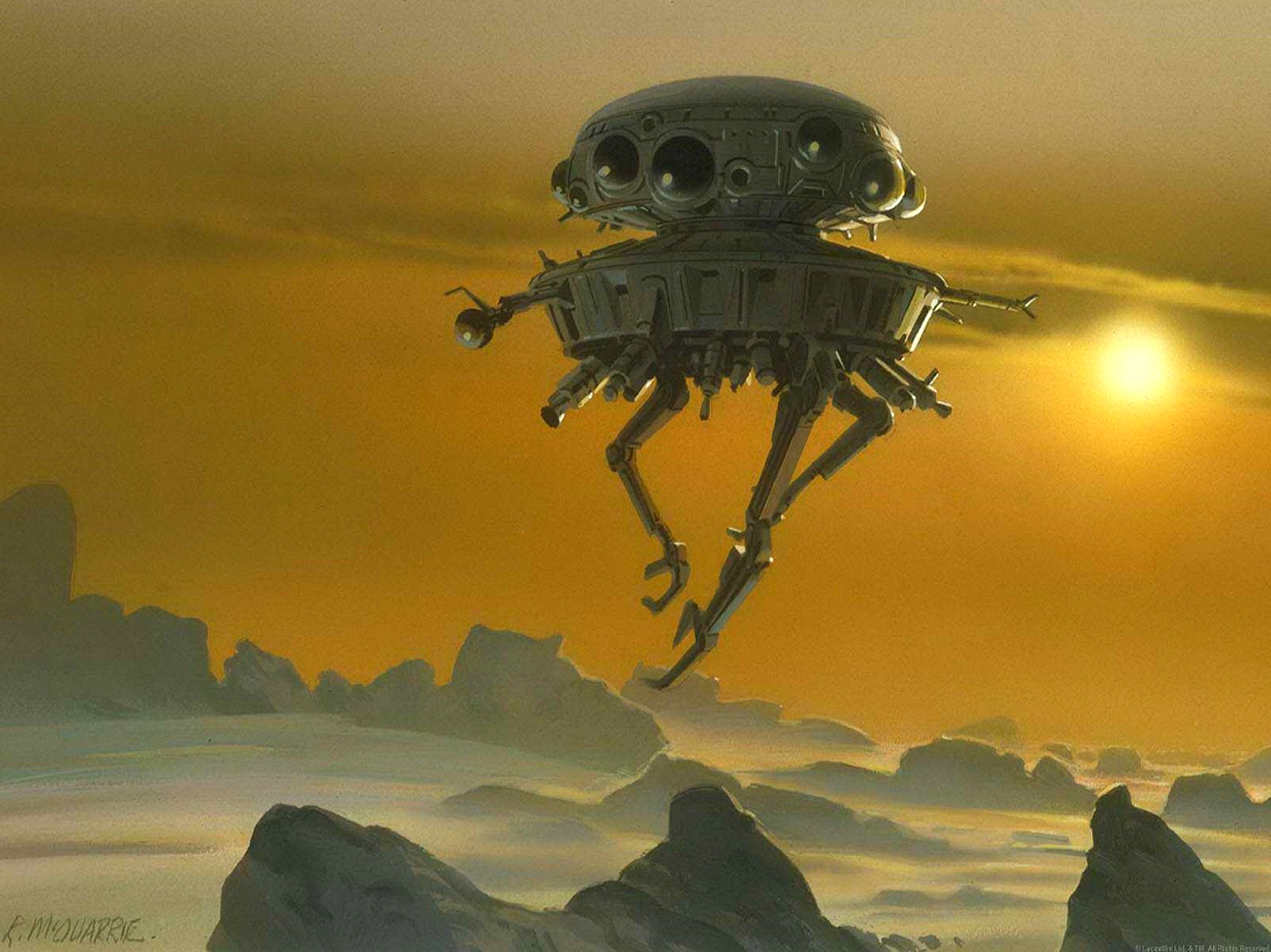
The movie THX 1138 features numerous radio voices that bear a striking resemblance to, and likely influenced, the unique electronic voice of the probe droid in Empire.
Star Wars: Rebellion: Prima's Official Strategy Guide clarifies that Imperial probe droids are equipped with small hyperdrives, enabling them to scout the galaxy independently of capital ships, for the video game Star Wars: Rebellion. This serves as the in-game explanation for why the Predator I Probe-Mate jump pod, the Viper probe droid's method of hyperspace travel, is not present in Star Wars: Rebellion.
Probe droids also appear in the 2006 video game LEGO Star Wars II: The Original Trilogy, a humorous LEGO-themed adaptation of the original trilogy. The game is also included in its 2007 compilation re-release.
It is important to note that the primary image used in this article depicts the damaged model from the Lucasfilm Archives, identifiable by its right antenna, which is slightly bent to the left.